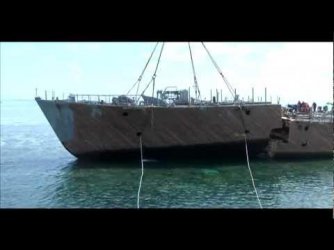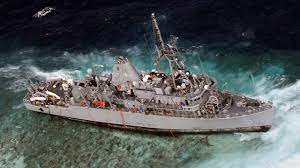You are using an out of date browser. It may not display this or other websites correctly.
You should upgrade or use an alternative browser.
You should upgrade or use an alternative browser.
Total bridge collapse in Baltimore...
- Thread starter *Jay*
- Start date
If a ship is going too fast, there's a good chance they'll lose the anchor. If they're cruising at 2-3 knots then it should slow the ship, but it's not like an arrestor on a fighter landing on a carrier. The number of "shots" of anchor chain paid out is in relation to water depth. If nothing else, dropping anchor may have altered the ship's course to avoid collision.Am i the only one that things dropping anchor wouldnt have done shit???
Thats a pile a tons moving...those shots aint gonna take that kinda hit....or am i waay wrong?
If a ship is going too fast, there's a good chance they'll lose the anchor. If they're cruising at 2-3 knots then it should slow the ship, but it's not like an arrestor on a fighter landing on a carrier. The number of "shots" of anchor chain paid out is in relation to water depth. If nothing else, dropping anchor may have altered the ship's course to avoid collision.
Exactly my point...at 10kts when she lost power dropping the anchor isnt doing shit...it may pull the ship one direction or another but that chain isnt gonna last long at that speed.
I mean it wouldnt have caused anything worse than what happened but i still dont think dropped the anchor would helped much...what was impact speed 2-3kts?....still thats a pile of momentum
Am i the only one that things dropping anchor wouldnt have done shit???
Thats a pile a tons moving...those shots aint gonna take that kinda hit....or am i waay wrong?
I was thinking about this as well… no telling wtf is dragging across the bottom of that bay… that anchor might rip up all sorts of cables to include high voltage power lines…
In most cases it is just the weight of the anchor and chain that keeps a ship relatively stationary. The anchor doesn't really imbed itself into the sea floor to keep a ship at anchor. Yeah, it may have just slowed the ship, or it could've parted the anchor chain. Who knows. I'm sure there'll be some retired Cargo Ship captain on the news to explain what did/didn't happen soon enough....Exactly my point...at 10kts when she lost power dropping the anchor isnt doing shit...it may pull the ship one direction or another but that chain isnt gonna last long at that speed
I'd be surprised if the IBS on a ship built in 2015 didn't have it's ECDIS managing the rudder to enable track following. Big fuel savings at stake. However, all that goes out the window when there's no engine power to turn the propeller or hydraulics to swing the rudder. Track following isn't brain surgery and with the speed they were carrying, they could have probably kept on course and missed the bridge as they slowed down if they had rudder control.Possibly it is equipped, but I don't think many ships can be remote piloted. More believeable is that the ship lost power, didn't have adequate time to drop anchor or recover the electric plant
Also, speaking of speeds, I thought again about the timing from the loss of power to the grounding and it occurred to me that a ship that big can't slow from 10kt to 2kt in half a nautical mile. The 2kt speed on the website is probably an artifact of the website interpolating the vessel's speed - it was 10kt at the start and zero after grounding so it shows a smooth slow-down, not the sudden stop they probably really had.
However, things don't change much if you assume it only slowed to 8kt instead of 2kt. There would have been 3 minutes and 20 seconds between loss of power and grounding instead of 5 minutes, and the cross-current would have been 1.5kts instead of 1. Different numbers, same conclusion.
Brings up a good point about sea cables. Inland navigation charts will show any hazards to navigation, and prohibited anchorage zones.I was thinking about this as well… no telling wtf is dragging across the bottom of that bay… that anchor might rip up all sorts of cables to include high voltage power lines…
In most cases it is just the weight of the anchor and chain that keeps a ship relatively stationary. The anchor doesn't really imbed itself into the sea floor to keep a ship at anchor. Yeah, it may have just slowed the ship, or it could've parted the anchor chain. Who knows. I'm sure there'll be some retired Cargo Ship captain on the news to explain what did/didn't happen soon enough....
Diversity hire took his job.

When navigating in/out of harbor, fuel savings goes out the window. I agree that auto-pilot saves fuel in open ocean, but am extremely doubtful that helm control would be reliant on ECDIS and/or radar input. ECDIS (I thought) was limited to electronic charts and not ship's control. What would suck is the radar operator calling out range to the bridge every few seconds and the (ship's) Bridge Crew knowing there'd be a collision......I'd be surprised if the IBS on a ship built in 2015 didn't have it's ECDIS managing the rudder to enable track following. Big fuel savings at stake. However, all that goes out the window when there's no engine power to turn the propeller or hydraulics to swing the rudder. Track following isn't brain surgery and with the speed they were carrying, they could have probably kept on course and missed the bridge as they slowed down if they had rudder control.
Also, speaking of speeds, I thought again about the timing from the loss of power to the grounding and it occurred to me that a ship that big can't slow from 10kt to 2kt in half a nautical mile. The 2kt speed on the website is probably an artifact of the website interpolating the vessel's speed - it was 10kt at the start and zero after grounding so it shows a smooth slow-down, not the sudden stop they probably really had.
However, things don't change much if you assume it only slowed to 8kt instead of 2kt. There would have been 3 minutes and 20 seconds between loss of power and grounding instead of 5 minutes, and the cross-current would have been 1.5kts instead of 1. Different numbers, same conclusion.
Oh i know....i had a stuck anchor once nearly sink me in bad weather in the gomex one time...i told my buddy to cut that bitch before wr are really ****ed.In most cases it is just the weight of the anchor and chain that keeps a ship relatively stationary. The anchor doesn't really imbed itself into the sea floor to keep a ship at anchor. Yeah, it may have just slowed the ship, or it could've parted the anchor chain. Who knows. I'm sure there'll be some retired Cargo Ship captain on the news to explain what did/didn't happen soon enough....
And im sure there will be tons of experts on the news who have never skippered anything bigger than a harbor tug lol
Not that there couldn't be underwater transmission lines but above distribution voltages, utilities do everything they can to keep lines overhead. Having spoken to employees of American Transmission Company, the general consensus is UG transmission lines cost 4-8X what overhead lines cost.I was thinking about this as well… no telling wtf is dragging across the bottom of that bay… that anchor might rip up all sorts of cables to include high voltage power lines…
Whatever utility is out there made a significant investment in a double circuit overhead line that runs parallel to the bridge as seen from Google Street view.
I can't imagine a need in which water/sewer/gas would need be underwater through the area however looking at at Google Earth I do see some tunnels farther inside the harbor. That would be another mess if an anchor of a big ship were to hook on one of those though it would probably be unlikely.
Looks to be exactly what happened. Saw a good video where it shows it dropping power over and over till it finally hit then dropped for the last time. They had no ability to do anything but go where the water took them. Dropping anchors just don't work that way and not on something that huge.Possibly it is equipped, but I don't think many ships can be remote piloted. More believeable is that the ship lost power, didn't have adequate time to drop anchor or recover the electric plant
"Sound collision!!!!" That would suck knowin youre along for the ride at that pointWhen navigating in/out of harbor, fuel savings goes out the window. I agree that auto-pilot saves fuel in open ocean, but am extremely doubtful that helm control would be reliant on ECDIS and/or radar input. ECDIS (I thought) was limited to electronic charts and not ship's control. What would suck is the radar operator calling out range to the bridge every few seconds and the (ship's) Bridge Crew knowing there'd be a collision......
Electronic charts can also be horrible. Take the USS Guardian for example, here is one of our Minesweepers. CIC and the Bridge were going off them with no checks and balances. They were wrong and the ship died on a reef and had to be dismantled on that reef. The cost was enormous.When navigating in/out of harbor, fuel savings goes out the window. I agree that auto-pilot saves fuel in open ocean, but am extremely doubtful that helm control would be reliant on ECDIS and/or radar input. ECDIS (I thought) was limited to electronic charts and not ship's control. What would suck is the radar operator calling out range to the bridge every few seconds and the (ship's) Bridge Crew knowing there'd be a collision......
Attachments
Dropping anchor isn't designed to be used as a braking system, but any action a ship's captain takes to avoid collision is a good one.Looks to be exactly what happened. Saw a good video where it shows it dropping power over and over till it finally hit then dropped for the last time. They had no ability to do anything but go where the water took them. Dropping anchors just don't work that way and not on something that huge.
Might have slowed them down enough to save a life...a bridge...who knows.Dropping anchor isn't designed to be used as a braking system, but any action a ship's captain takes to avoid collision is a good one.
Bummer. Conducting visual fixes is routine if piloting in/out of port. Submarines either ground or collide with a charted sea mount. HARTFORD and SAN FRANCISCO FAFO'd with the sea floor.....Electronic charts can also be horrible. Take the USS Guardian for example, here is one of our Minesweepers. CIC and the Bridge were going off them with no checks and balances. They were wrong and the ship died on a reef and had to be dismantled on that reef. The cost was enormous.
Indeed...speculation...but phoenix make a good point too....in the eyes on the examiners and investigstions any move to slow the ship or avoid collision is a good move in their eyesMight have slowed them down enough to save a life...a bridge...who knows.
Part of the "Rules of the Road"Indeed...speculation...but phoenix make a good point too....in the eyes on the examiners and investigstions any move to slow the ship or avoid collision is a good move in their eyes
Users who are viewing this thread
Total: 3 (members: 0, guests: 3)




